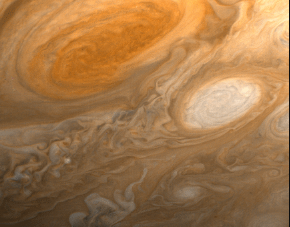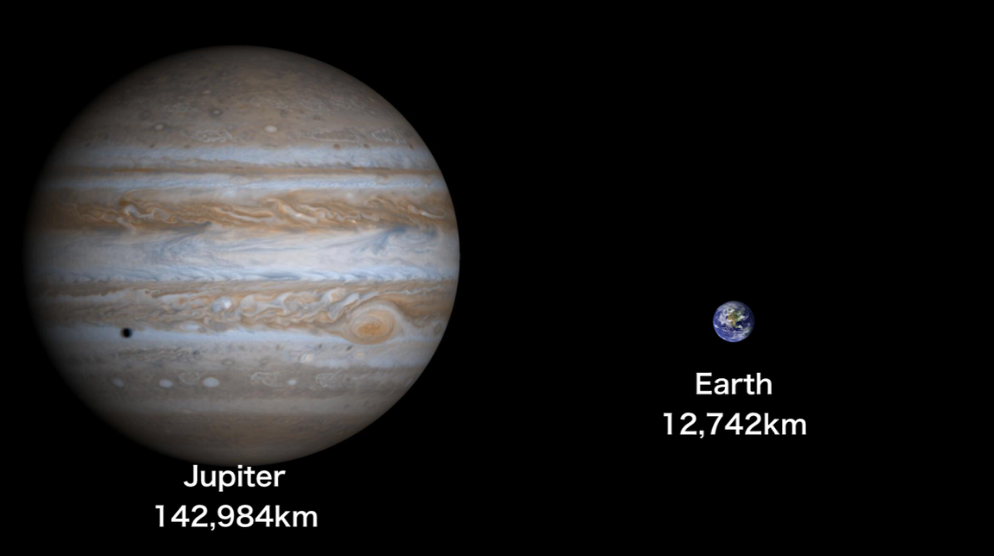
Jupiter Introduction
Jupiter is the fifth of the eight planets in the solar system, 5.2 AU from the Sun.
Jupiter is the largest planet in the solar system. To what extent is Jupiter? To compare, if Jupiter is a hollow sphere, then there can be about 1,300 Earth inside, which shows how big the planet is. But because of the density of Jupiter The Earth is low, and its mass is only 317 times that of the Earth. The picture on the left is a picture of Jupiter and Earth in proportion.
Planets outside Jupiter, including Saturn, Uranus, Neptune, etc., are mainly composed of gases, commonly known as wood-like planets.
Jupiter’s topographical appearance
Jupiter’s surface has red, brown, white and other colorful stripe patterns. It can be inferred that the wind direction in Jupiter’s atmosphere is parallel to the equator direction. The west wind and the east wind are alternately blown by different regions, which is a distinct feature of Jupiter’s atmosphere. The atmosphere contains very little organic components such as methane and ethane, and there is a thunder phenomenon, and the probability of generating organic matter is quite large.
The biggest feature of Jupiter’s surface is the erythema of the southern hemisphere. This huge circular vortex is more than three times the diameter of the Earth. The red color of the red spot is impressive, and the color seems to come from red phosphorus.
The scientists detected sulfur from the atmospheric components released by the collision of the comet Shoemaker-Levy 9 and learned that the Jupiter atmosphere contains sulfur.

Great red spot
Jupiter’s surface environment
Most of Jupiter’s ingredients are hydrogen and helium. Jupiter is far from the sun, the surface temperature is as low as minus 150 degrees Celsius, and the heat inside Jupiter is more than twice the heat it receives from the sun, so if Jupiter only relies on the heat of the sun to warm it, the surface temperature is still Will be 20 degrees lower.
Jupiter’s astral structure
The surface of Jupiter is composed of liquid hydrogen and helium. It is a liquid metal hydrogen deep in the center of the earth. Its core is a rock core, about twice as large as the earth, ten times heavier.
Jupiter has a very large magnetic field, and the surface magnetic field is 10 times stronger than Earth. Jupiter’s magnetosphere distribution is more than 100 times larger than the Earth’s magnetosphere, making it the largest magnetosphere in the solar system. Due to the role of the solar wind and the magnetosphere, Jupiter also produces aurora in the polar regions like the Earth.
Jupiter’s planetary ring
Jupiter also has a ring, but it is far less than Saturn’s ring. According to the results of spectral observation from the ground, the composition of Jupiter’s thin ring may be rock (catenate) with a width of more than 100,000 kilometers.
Jupiter’s moon

With more than 61 satellites, Jupiter is the planet with the most satellites in the solar system. Four of them are particularly large near the inside. From the end near Jupiter, the order is: Io, Europa, Ganimede, Calisto, first discovered by the physicist Galileo, also known as Galileo’s four major satellites.
The picture below shows a photograph of Jupiter and its satellites taken by Mars Global Surveyor (MGS) on Mars orbit on May 8, 2003, from left to right, Calisto, and Ghanmet. Jupiter, and Europa. Jupiter and its Galilean Satellites as viewed from Mars

source: NASA/JPL-Caltech
It can be seen from the figure that the size of Jupiter is different from that of the satellite. With the exception of Europa, each Galilean satellite is larger than the moon, and Garnimet is even larger than Mercury. Io is about the size of the moon, but has many active volcanoes and frequent crust movements. Some people argue that the energy of the Io active volcano comes from the mighty tidal power of Jupiter. The surface of Europa is covered with countless striped road patterns, and there is almost no crater on it. It is very strange. This means that the surface of Europa is relatively new. With a radius of about 2,600 kilometers, Ganimede is the largest of all satellites in the solar system, even larger than Mercury in the nine planets.
Jupiter observations
The average small binoculars can see Jupiter and the four satellites beside him, because his luminosity is so bright that he can find his position in the night sky even in a metropolis. In small astronomical telescopes, you can see Jupiter’s clearer structures such as the Great Red Spot and the four major satellites, and the relative position of the satellite and Jupiter will change over time, just like a “small solar system”, very interesting.
HD big picture (click on the picture to see the high-definition big picture)



